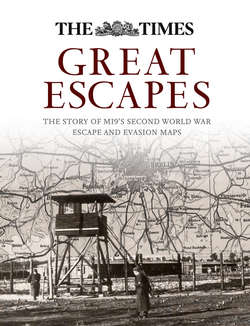Читать книгу Great Escapes: The story of MI9’s Second World War escape and evasion maps - Barbara Bond - Страница 11
THE TRAINING SCHOOL AT HIGHGATE
ОглавлениеSection D of MI9 was responsible for training and briefing the Intelligence Officers who attended courses at the Training School in Highgate and who then returned to their individual units to provide training to operational crews. Certainly in the early years, these training courses concentrated on the RAF whose crews were constantly overflying occupied Europe. The lecturers engaged were largely those who had personal experience of escape in World War I. Their remuneration was set at two guineas (£2. 2s. 0d.), the equivalent of around £82 today, for each lecture they delivered and they were also provided with travel and overnight hotel expenses when they travelled to deliver lectures at operational units. As early as January 1940, a conference was organized in Room 660 of the Metropole Building to hear a lecture delivered by Johnny Evans. By the end of February 1940, lecturers from the Training School had delivered their training lectures to seven Army Divisions, and five RAF Groups, and were undertaking a tour of the British Expeditionary Force (BEF).
The content of the general lecture given to officers and senior noncommissioned officers (NCOs) included emphasis on the undesirability of capture, instructions on evasion, conduct on capture and a demonstration of some of the aids to escape which were issued to units prior to deployment. The lecture emphasized that the job was to fight and avoid capture. If captured, it was their first and principal duty to escape at the earliest opportunity. Later on in the war, with the increasing numbers of prisoners of war and the increasing organization of Escape Committees in the camps, the lectures were updated to include mention of the Escape Committees, which were the responsibility of the Senior British Officer in each of the camps.
Those attending the training courses were told that money, maps, identity papers, provisions and many other escape aids would be made available through the Committees. The officers and NCOs who attended the lectures were then responsible for cascading the briefing down through the ranks, but they were, initially at least, specifically directed not to mention the aids to escape as they were only available for issue in limited numbers. It was recommended that they deliver the lecture as an informal talk, classified SECRET, and to audiences which should not exceed 200 at any one time. Later on, and certainly by early 1942, a supply of aids for demonstration purposes was provided to local commands.
There was also a classified TOP SECRET lecture on codes which was delivered under the title of ‘Camp Conditions’ to very limited audiences, never more than ten at a time, all of whom had been carefully selected. Those selected for this special briefing were required to practise the use of letter codes and their work was carefully checked before they were formally registered as authorized code users. Section Y was responsible for codes. The development of letter codes as a means of communication with the camps was also regarded as a priority from the start and the role which coded communication played in the escape programme developed apace. This aspect is discussed in detail in Chapter 5.
The staff in the Training School steadily compiled a training manual which became known as the Bulletin. The Bulletin served an important role as a tool in educating potential prisoners of war about possible escape routes and the nature of escape aids, including maps, which were being produced (see Chapter 4).
The pressures on the lecturing staff were considerable and continually increased as the war progressed. Initially both the Royal Navy and the Army had appeared uninterested in the training courses offered and, certainly in the first year or so of its existence, MI9 staff worked hard to stimulate interest and used many personal contacts to raise awareness of their work. They appeared to overcome some initial opposition from the Royal Navy and some Army commands, and by May 1944 the record shows that very significant numbers in all three services had been briefed: 110,000 in the Royal Navy and the Royal Marines, 346,000 in the Army and 290,000 in the Royal Air Force, and a total of 3,250 lectures had been delivered.
